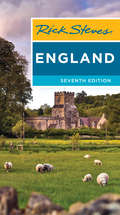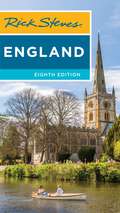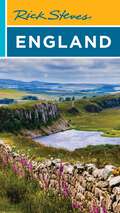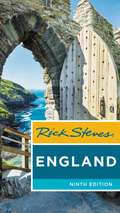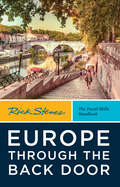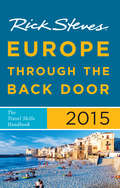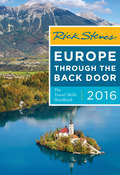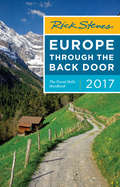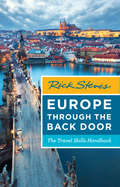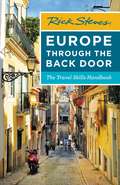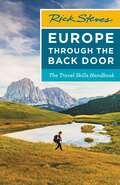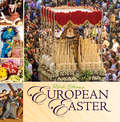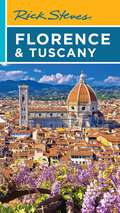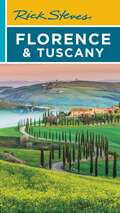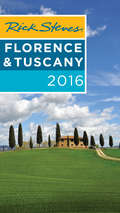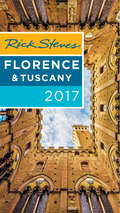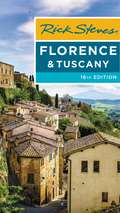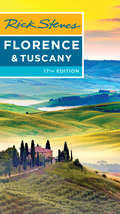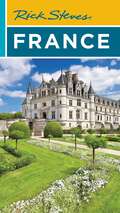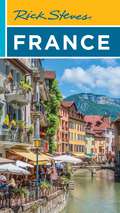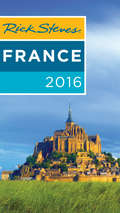- Table View
- List View
Rick Steves Eastern Europe (Rick Steves)
by Rick Steves Cameron HewittFrom romantic cities steeped in history to the stunning slopes of the Alps, get to know this exciting slice of Europe: with Rick Steves on your side, Eastern Europe can be yours! Inside Rick Steves Eastern Europe you'll find:Comprehensive coverage for spending two weeks or more exploring Eastern EuropeRick's strategic advice on how to get the most out of your time and money, with rankings of his must-see favoritesTop sights and hidden gems, from the cobbles of bustling Bratislava, to country roads winding through the Julian Alps, to the striking chapels and cathedrals of Prague's Castle QuarterHow to connect with culture: Bask in the energy of Kraków's Main Square Market, sample local wines from Hungarian vintners, or soak in the steamy thermal baths in BudapestBeat the crowds, skip the lines, and avoid tourist traps with Rick's candid, humorous insightThe best places the eat, sleep, and relaxSelf-guided walking tours of lively neighborhoods and historic museumsDetailed neighborhood maps for exploring on the goUseful resources including a packing list, phrase books, historical overviews, and recommended readingOver 1,000 bible-thin pages include everything worth seeing without weighing you downComplete, up-to-date information on the Czech Republic, Poland, Hungary, Slovenia, Austria, and Slovakia, plus side trips to Croatia, Bosnia-Herzegovina, Montenegro, Bulgaria, and RomaniaMake the most of every day and every dollar with Rick Steves Eastern Europe.
Rick Steves England
by Rick StevesYou can count on Rick Steves to tell you what you really need to know when traveling in England.In this guide, you'll find a mix of splendid cities, ever-so-quaint villages, historic ports, and seaside resorts. Visit the manors, museums, cathedrals, and castles that preserve England's history. Explore the scenic bays of Cornwall, hike the wild moors of Dartmoor, and discover why the Lake District is Londoners' favorite playground. Travel back in time at Stonehenge, tour the remnants of the Roman Empire along Hadrian's Wall, and see the ancient baths in the city of Bath. After a bustling day of sightseeing, relax at a neighborhood pub, sharing a chat and a pint with a friendly local.Rick's candid, humorous advice will guide you to good-value hotels and restaurants. You'll learn how to get around England by train, bus, or car, and discover which sights are worth your time and money. More than just reviews and directions, a Rick Steves guidebook is a tour guide in your pocket.
Rick Steves England
by Rick StevesHike the wild moors of Dartmoor, explore the scenic bays of Cornwall, and dive into history at Hadrian's Wall: England is yours to discover with Rick Steves! Inside Rick Steves England you'll find:Comprehensive coverage for spending two weeks or more in England Rick's strategic advice on how to get the most out of your time and money, with rankings of his must-see favorites Top sights and hidden gems, from the ancient and mysterious Stonehenge to cozy corner pubs How to connect with local culture: Enjoy an evening at the theatre, take high tea in a classic hotel, or cheer on the team with fans at a football match Beat the crowds, skip the lines, and avoid tourist traps with Rick's candid, humorous insight The best places to eat, sleep, and relax with a pint Self-guided walking tours of lively neighborhoods, historic sites, and museums Detailed neighborhood and museum maps for exploring on the go Useful resources including a packing list, a phrase book of British slang, a historical overview, and recommended reading Over 900 bible-thin pages include everything worth seeing without weighing you down Complete, up-to-date information on London, Windsor and Cambridge, Canterbury, Dover, Brighton, Portsmouth, Dartmoor, Cornwall, Penzance, St. Ives, Penwith Peninsula, Bath, Glastonbury, Wells, Avebury, Stonehenge, Salisbury, Oxford, the Cotswolds, Stratford-upon-Avon, Warwick, Coventry, Ironbridge Gorge, Liverpool, Blackpool, the Lake District, Yorkshire, Durham, and more Make the most of every day and every dollar with Rick Steves England. Visiting for less than two weeks? Try Rick Steves Best of England.
Rick Steves England (Rick Steves)
by Rick StevesHike the wild moors of Dartmoor, explore the scenic bays of Cornwall, and dive into history at Hadrian's Wall: with Rick Steves on your side, England can be yours!Inside Rick Steves England you'll find:Comprehensive coverage for spending a week or more exploring EnglandRick's strategic advice on how to get the most out of your time and money, with rankings of his must-see favoritesTop sights and hidden gems, from the ancient and mysterious Stonehenge to cozy corner pubsHow to connect with local culture: Catch the premier of a new musical, chat with fans about the latest football match, or take high tea in a classic hotelBeat the crowds, skip the lines, and avoid tourist traps with Rick's candid, humorous insightThe best places to eat, sleep, and relax over a pintSelf-guided walking tours of lively neighborhoods and incredible museums Detailed neighborhood maps for exploring on the goUseful resources including a packing list, a phrase book of British slang, a historical overview, and recommended readingOver 900 bible-thin pages include everything worth seeing without weighing you downComplete, up-to-date information on London, Windsor and Cambridge, Canterbury, Dover, Brighton, Portsmouth, Dartmoor, Cornwall, Penzance, St. Ives, Penwith Peninsula, Bath, Glastonbury, Wells, Avebury, Stonehenge, Salisbury, Oxford, the Cotswolds, Stratford-upon-Avon, Warwick, Coventry, Ironbridge Gorge, Liverpool, Blackpool, the Lake District, Yorkshire, Durham, and moreMake the most of every day and every dollar with Rick Steves England.Spending just a few days in the city? Try Rick Steves Pocket London.
Rick Steves England: With Edinburgh (Rick Steves)
by Rick StevesHike the wild moors of Dartmoor, explore the scenic bays of Cornwall, and dive into history at Hadrian's Wall: England is yours to discover with Rick Steves! Inside Rick Steves England you'll find:Comprehensive coverage for spending two weeks or more in England Rick's strategic advice on how to get the most out of your time and money, with rankings of his must-see favorites Top sights and hidden gems, from the ancient and mysterious Stonehenge to cozy corner pubs How to connect with local culture: Enjoy an evening at the theatre, take high tea in a classic hotel, or cheer on the team with fans at a football match Beat the crowds, skip the lines, and avoid tourist traps with Rick's candid, humorous insight The best places to eat, sleep, and relax with a pint Self-guided walking tours of lively neighborhoods, historic sites, and museums Detailed neighborhood and museum maps for exploring on the go Useful resources including a packing list, a phrase book of British slang, a historical overview, and recommended reading Over 900 bible-thin pages include everything worth seeing without weighing you down Complete, up-to-date information on London, Windsor and Cambridge, Canterbury, Dover, Brighton, Portsmouth, Dartmoor, Cornwall, Penzance, St. Ives, Penwith Peninsula, Bath, Glastonbury, Wells, Avebury, Stonehenge, Salisbury, Oxford, the Cotswolds, Stratford-upon-Avon, Warwick, Coventry, Ironbridge Gorge, Liverpool, Blackpool, the Lake District, Yorkshire, Durham, and more Make the most of every day and every dollar with Rick Steves England. Planning a shorter trip? Try Rick Steves Best of England.
Rick Steves England: With Edinburgh (Travel Ser.)
by Rick StevesHike the wild moors of Dartmoor, explore the scenic bays of Cornwall, and dive into history at Hadrian's Wall: England is yours to discover with Rick Steves! Inside Rick Steves England you'll find:Comprehensive coverage for spending two weeks or more in EnglandRick's strategic advice on how to get the most out of your time and money, with rankings of his must-see favoritesTop sights and hidden gems, from the ancient and mysterious Stonehenge to cozy corner pubsHow to connect with local culture: Enjoy an evening at the theatre, take high tea in a classic hotel, or cheer on the team with fans at a football match Beat the crowds, skip the lines, and avoid tourist traps with Rick's candid, humorous insightThe best places to eat, sleep, and relax with a pintSelf-guided walking tours of lively neighborhoods, historic sites, and museumsDetailed neighborhood and museum maps for exploring on the goUseful resources including a packing list, a phrase book of British slang, a historical overview, and recommended readingOver 900 bible-thin pages include everything worth seeing without weighing you downComplete, up-to-date information on London, Windsor and Cambridge, Canterbury, Dover, Brighton, Portsmouth, Dartmoor, Cornwall, Penzance, St. Ives, Penwith Peninsula, Bath, Glastonbury, Wells, Avebury, Stonehenge, Salisbury, Oxford, the Cotswolds, Stratford-upon-Avon, Warwick, Coventry, Ironbridge Gorge, Liverpool, Blackpool, the Lake District, Yorkshire, Durham, and moreMake the most of every day and every dollar with Rick Steves England.Visiting for less than two weeks? Try Rick Steves Best of England.
Rick Steves Europe Through the Back Door
by Rick StevesYou can count on Rick Steves to tell you what you really need to know when traveling through Europe. With Rick Steves Europe Through the Back Door, you'll learn how to: Plan your itinerary and maximize your time Pack light and right Find good-value hotels and restaurants Travel smoothly by train, bus, car, and plane Avoid crowds and tourist scams Hurdle the language barrier Understand cultural differences and connect with locals Save money while enjoying the trip of a lifetime After 40+ years of exploring Europe, Rick considers this travel skills handbook his life's work, and with his expert introductions to the top destinations in Europe, choosing your next trip will be easy and stress-free. Using the travel skills in this book, you'll experience the culture like a local, spend less money, and have more fun.
Rick Steves Europe Through the Back Door 2015
by Rick StevesYou can count on Rick Steves to tell you what you really need to know when traveling through Europe, including how to:Plan your itinerary and maximize your timePack light-and rightFind good-value hotels and restaurantsTravel smoothly by train, bus, car, and planeAvoid crowds and tourist scamsHurdle the language barrierUnderstand cultural differences and connect with localsSave money while enjoying the trip of a lifetimeAfter 30 years of exploring Europe, Rick considers this travel skills handbook his life's work. He shares his favorite off-the-beaten-path towns, trails, and natural wonders. With this guidebook, you'll experience the culture like a local, spend less money, and have more fun.
Rick Steves Europe Through the Back Door 2016
by Rick StevesYou can count on Rick Steves to tell you what you really need to know when traveling through Europe in this full-color guidebook, including how to: Plan your itinerary and maximize your time Pack light--and right Find good-value hotels and restaurants Travel smoothly by train, bus, car, and plane Avoid crowds and tourist scams Hurdle the language barrier Understand cultural differences and connect with localsSave money while enjoying the trip of a lifetime After more than three decades of exploring Europe, Rick considers this travel skills handbook his life’s work. He shares his favorite off-the-beaten-path towns, trails, and natural wonders in his multi-page summaries of each country, introducing you to the real treasures of Europe. With this guidebook you’ll experience the culture like a local, spend less money, and have more fun.
Rick Steves Europe Through the Back Door 2017
by Rick StevesYou can count on Rick Steves to tell you what you really need to know when planning a Grand Tour of Europe. In this guide, Rick covers the best of Austria, Belgium, the Czech Republic, France, Germany, Great Britain, Italy, the Netherlands, Spain, and Switzerland.You'll find a healthy mix of big cities, small towns, and exciting regions, including:London, Paris, Rome, Amsterdam, Prague, and BarcelonaRothenberg, Siena, Toledo, Hallstatt, and GimmelwaldProvence, the French Riviera, the Romantic Road, the Berner Oberland, and the Cinque TerreRick's candid, humorous advice will guide you to good-value hotels and restaurants. You'll learn how to find the right bus in Rome, an inexpensive crêpe in Paris, and which museums and sights are worth your time and money. More than just reviews and directions, a Rick Steves guidebook is a tour guide in your pocket.
Rick Steves Europe Through the Back Door: The Travel Skills Handbook
by Rick StevesYou can count on Rick Steves to tell you what you really need to know when traveling through Europe, including how to: Plan your itinerary and maximize your time Pack light-and right Find good-value hotels and restaurants Travel smoothly by train, bus, car, and plane Avoid crowds and tourist scams Hurdle the language barrier Understand cultural differences and connect with locals Save money while enjoying the trip of a lifetime After 30 years of exploring Europe, Rick considers this travel skills handbook his life's work. He shares his favorite off-the-beaten-path towns, trails, and natural wonders. With this guidebook, you'll experience the culture like a local, spend less money, and have more fun.
Rick Steves Europe Through the Back Door: The Travel Skills Handbook (Rick Steves Travel Guide)
by Rick StevesYou can count on Rick Steves to tell you what you really need to know when traveling through Europe. With Rick Steves Europe Through the Back Door, you'll learn how to:Plan your itinerary and maximize your timePack light and rightFind good-value hotels and restaurantsTravel smoothly by train, bus, car, and planeAvoid crowds and tourist scamsHurdle the language barrierUnderstand cultural differences and connect with localsSave money while enjoying the trip of a lifetimeAfter 40+ years of exploring Europe, Rick considers this travel skills handbook his life's work, and with his expert introductions to the top destinations in Europe, choosing your next trip will be easy and stress-free. Using the travel skills in this book, you'll experience the culture like a local, spend less money, and have more fun.
Rick Steves Europe Through the Back Door: The Travel Skills Handbook (Rick Steves Travel Guide)
by Rick StevesYou can count on Rick Steves to tell you what you really need to know when traveling through Europe. With Rick Steves Europe Through the Back Door, you'll learn how to:Plan your itinerary and maximize your timePack light and rightFind good-value hotels and restaurantsTravel smoothly by train, bus, car, and planeAvoid crowds and tourist scamsHurdle the language barrierUnderstand cultural differences and connect with localsSave money while enjoying the trip of a lifetimeTravel safely and hygienically in the wake of Covid-19After 40+ years of exploring Europe, Rick considers this travel skills handbook his life's work, and with his expert introductions to the top destinations in Europe, choosing your next trip will be easy and stress-free. Using the travel skills in this book, you'll experience the culture like a local, spend less money, and have more fun.
Rick Steves European Easter (Rick Steves)
by Rick StevesRick Steves, America's expert on Europe, explores the rich traditions, celebrations, and history behind some of Europe's most colorful and charming Easter celebrations. Discover Carnevale in Venice, Lent in Cantiano, Holy Week in Sevilla, Easter Sunday in Greece, and beyond.Rick examines "Easter Through the Ages," including the Biblical story of Easter and the pagan and secular traditions that have shaped the Easter celebrations of today. He compares the beliefs of Eastern and Western Orthodox traditions, and shows how holidays are uniquely celebrated across cities and countries. In Rome, the Vatican blesses palm fronds on Palm Sunday, while in Tuscany, olive branches are blessed instead. Churches in Sevilla display elaborate floats for Easter Sunday, while villages across Italy, Slovenia, and Greece celebrate with feasts.Touching on Italy, Slovenia, Switzerland, Spain, Greece, and the Vatican, and filled with fascinating insights and vibrant full-color photos, Rick Steves European Easter is a delightful way to understand Easter heritage from a multicultural perspective.
Rick Steves European Festivals
by Rick StevesIt's party time in Europe! Bestselling author Rick Steves explores the best festivals in Europe, from the Running of the Bulls in Spain to Carnival in Venice. There will be no museums! And no art galleries! Just Europeans having lots of fun. Across Europe, festival traditions go back centuries and are filled with time honored pageantry and ritual. Entire communities hurl themselves with abandon into the craziness. We'll careen all over Europe: the Palio horse races in Siena, the Highland games near Edinburgh, the colorful masquerade of Carnival in Venice, Slovenia, and Luzern, Easter festivities in Andalucía, Tuscany, and Greece, the springtime April Fair in Sevilla, Bastille Day in Paris, the Running of the Bulls in Pamplona, Oktoberfest in Munich, and Christmas markets and traditions in Nurnberg and Switzerland. With fascinating insights, rich history, and vivid photos, this great gift book captures the spirit of Europe's rich and fun-loving heritage. Hang on to your party hats!
Rick Steves Florence & Tuscany
by Rick Steves Gene OpenshawWalk in the footsteps of the Medici, sip aperitivi, and discover the cultural heart of Italy: with Rick as your guide, Tuscany is yours to discover. Inside Rick Steves Florence & Tuscany you'll find:Comprehensive coverage for spending a week or more exploring Florence and Tuscany Rick's strategic advice on how to get the most out of your time and money, with rankings of his must-see favorites Top sights and hidden gems, from the Uffizi Gallery and the Duomo to a 600-year-old perfumery How to connect with culture: Listen to a street musician's serenade on the Ponte Vecchio, stroll through a morning market sampling freshly-made pasta, and sip full-bodied wines with Montalcino locals at a corner enoteca Beat the crowds, skip the lines, and avoid tourist traps with Rick's candid, humorous insight The best places to eat, sleep, and relax with a glass of Chianti Self-guided walking tours of lively neighborhoods and incredible museums Detailed maps throughout,plus a handy fold-out map and driving tours through the heart of Tuscany and Brunello wine country Useful resources including a packing list, a historical overview, and recommended reading Over 700 bible-thin pages include everything worth seeing without weighing you down Complete, up-to-date information on Florence, Siena, Pisa, Lucca, Volterra, San Gimignano, Montepulciano, Pienza, Montalcino, Cortona, and more Make the most of every day and every dollar with Rick Steves Florence & Tuscany. Spending less than a week exploring Florence? Try Rick Steves Pocket Florence.
Rick Steves Florence & Tuscany (Rick Steves Travel Guide)
by Rick Steves Gene OpenshawNow more than ever, you can count on Rick Steves to tell you what you really need to know when traveling through Florence and Tuscany. Walk in the footsteps of the Medici, sip aperitivi, and discover the cultural heart of Italy: with Rick as your guide, Tuscany is yours to discover. Inside Rick Steves Florence & Tuscany you'll find:Fully updated, comprehensive coverage for spending a week or more exploring Florence and TuscanyRick's strategic advice on how to get the most out of your time and money, with rankings of his must-see favoritesTop sights and hidden gems, from the Uffizi Gallery and the Duomo to a 600-year-old perfumeryHow to connect with local culture: Listen to a street musician's serenade on the Ponte Vecchio, stroll through a morning market sampling freshly-made pasta, and sip full-bodied wines with Montalcino locals at a corner enotecaBeat the crowds, skip the lines, and avoid tourist traps with Rick's candid, humorous insightThe best places to eat, sleep, and relax with a glass of ChiantiSelf-guided walking tours of lively neighborhoods and incredible museumsDetailed maps for exploring on the go, including driving tours through the heart of Tuscany and Brunello wine countryComplete, up-to-date information on Florence, Siena, Pisa, Lucca, Volterra, San Gimignano, Montepulciano, Pienza, Montalcino, Cortona, and moreCovid-related travel info and resources for a smooth tripMake the most of every day and every dollar with Rick Steves Florence & Tuscany.Spending less than a week exploring Florence? Try Rick Steves Pocket Florence.
Rick Steves Florence & Tuscany 2015
by Rick Steves Gene OpenshawYou can count on Rick Steves to tell you what you really need to know when traveling through Florence and Tuscany.With the self-guided tours in this book, you'll discover the geographic heart of Italy. <P><P>Take the Renaissance Walk and tour the Uffizi Gallery to learn how Florence taught civilized living to the rest of Europe. Wander through the medieval city of Siena and find out what Pisa has to offer beyond the Leaning Tower. Relax in sunny Tuscan hill towns where you'll enjoy full-bodied wine, the world's best gelato, and the company of friendly locals.Rick's candid, humorous advice will guide you to good-value hotels and restaurants. You'll learn how to get around by train, bus, or rental car and get up-to-date advice on what's worth your time and money. More than just reviews and directions, a Rick Steves guidebook is a tour guide in your pocket.
Rick Steves Florence & Tuscany 2017
by Rick Steves Gene OpenshawYou can count on Rick Steves to tell you what you really need to know when traveling through Florence and Tuscany.With the self-guided tours in this book, you'll discover the geographic heart of Italy. Take the Renaissance Walk and tour the Uffizi Gallery to learn how Florence taught civilized living to the rest of Europe. Wander through the medieval city of Siena and find out what Pisa has to offer beyond the Leaning Tower. Relax in sunny Tuscan hill towns where you'll enjoy full-bodied wine, the world's best gelato, and the company of friendly locals.Rick's candid, humorous advice will guide you to good-value hotels and restaurants. You'll learn how to get around by train, bus, or rental car and get up-to-date advice on what's worth your time and money. More than just reviews and directions, a Rick Steves guidebook is a tour guide in your pocket.
Rick Steves Florence & Tuscany: Should It Be Florence And Tuscany? (Rick Steves Travel Guide)
by Rick Steves Gene OpenshawWalk in the footsteps of the Medici, sip aperitivi, and discover the cultural heart of Italy: with Rick Steves, Tuscany is yours to discover. Inside Rick Steves Florence & Tuscany you'll find:Comprehensive coverage for spending a week or more exploring Florence and TuscanyRick's strategic advice on how to get the most out of your time and money, with rankings of his must-see favoritesTop sights and hidden gems, from the Uffizi Gallery and the Duomo to a 600-year-old perfumeryHow to connect with local culture: Listen to a street musician's serenade on the Ponte Vecchio, stroll through a morning market sampling freshly-made pasta, and sip full-bodied wines with Montalcino locals at a corner enotecaBeat the crowds, skip the lines, and avoid tourist traps with Rick's candid, humorous insightThe best places to eat, sleep, and relax with a glass of ChiantiSelf-guided walking tours of lively neighborhoods and incredible museumsDetailed maps for exploring on the go, including driving tours through the heart of Tuscany and Brunello wine countryUseful resources including a packing list, Italian phrase book, historical overview, and recommended readingOver 400 bible-thin pages include everything worth seeing without weighing you downComplete, up-to-date information on Florence, Siena, Pisa, Lucca, Volterra, San Gimignano, Montepulciano, Pienza, Montalcino, Cortona, and moreMake the most of every day and every dollar with Rick Steves Florence & Tuscany.Spending less than a week exploring Florence? Try Rick Steves Pocket Florence.
Rick Steves Florence & Tuscany: Should It Be Florence And Tuscany? (Rick Steves)
by Rick Steves Gene OpenshawYou can count on Rick Steves to tell you what you really need to know when traveling through Florence and Tuscany.With the self-guided tours in this book, you'll discover the geographic heart of Italy. Take the Renaissance Walk and tour the Uffizi Gallery to learn how Florence taught civilized living to the rest of Europe. Wander through the medieval city of Siena and find out what Pisa has to offer beyond the Leaning Tower. Relax in sunny Tuscan hill towns where you'll enjoy full-bodied wine, the world's best gelato, and the company of friendly locals.Rick's candid, humorous advice will guide you to good-value hotels and restaurants. You'll learn how to get around by train, bus, or rental car and get up-to-date advice on what's worth your time and money. More than just reviews and directions, a Rick Steves guidebook is a tour guide in your pocket.
Rick Steves France (Rick Steves Snapshot Ser.)
by Rick Steves Steve SmithNow more than ever, you can count on Rick Steves to tell you what you really need to know when traveling through France. Wander the lavender fields of Provence, climb the steps of the Eiffel Tower, and bite into a perfect croissant: Inside Rick Steves France you'll find:Fully updated, comprehensive coverage for planning a multi-week trip to FranceRick's strategic advice on how to get the most out of your time and money, with rankings of his must-see favoritesTop sights and hidden gems, from the Louvre and the Palace of Versailles to neighborhood cafés and delicate macaronsHow to connect with local culture: Stroll through open-air markets in Paris, bike through rustic villages, and taste wines in Burgundy and BordeauxBeat the crowds, skip the lines, and avoid tourist traps with Rick's candid, humorous insightThe best places to eat, sleep, and relax with a glass of vin rougeSelf-guided walking tours of lively neighborhoods and incredible museumsVital trip-planning tools, like how to link destinations, build your itinerary, and get from place to placeDetailed maps, including a fold-out map for exploring on the goOver 1,000 bible-thin pages include everything worth seeing without weighing you downCoverage of Paris, Chartres, Normandy, Mont St-Michel, Brittany, The Loire, Dordogne, Languedoc-Roussillon, Provence, The French Riviera, Nice, Monaco, The French Alps, Burgundy, Lyon, Alsace, Reims, Verdun, and much moreCovid-related travel info and resources for a smooth tripMake the most of every day and every dollar with Rick Steves France.Planning a one- to two-week trip? Check out Rick Steves Best of France.
Rick Steves France (Rick Steves)
by Rick Steves Steve SmithNow more than ever, you can count on Rick Steves to tell you what you really need to know when traveling through France. Wander the lavender fields of Provence, climb the steps of the Eiffel Tower, and bite into a perfect croissant. Inside Rick Steves France you'll find:Fully updated, comprehensive coverage for planning a multi-week trip to France Rick's strategic advice on how to get the most out of your time and money, with rankings of his must-see favorites Top sights and hidden gems, from the Louvre and the Palace of Versailles to neighborhood cafés and delicate macarons How to connect with local culture: Stroll through open-air markets in Paris, bike through rustic villages, and taste wines in Burgundy and Bordeaux Beat the crowds, skip the lines, and avoid tourist traps with Rick's candid, humorous insight The best places to eat, sleep, and relax with a glass of vin rougeSelf-guided walking tours of lively neighborhoods and incredible museums Vital trip-planning tools, like how to link destinations, build your itinerary, and get from place to place Detailed maps, including a fold-out map for exploring on the go Over 1,000 bible-thin pages include everything worth seeing without weighing you down Coverage of Paris, Chartres, Normandy, Mont St-Michel, Brittany, The Loire, Dordogne, Languedoc-Roussillon, Provence, The French Riviera, Nice, Monaco, The French Alps, Burgundy, Lyon, Alsace, Reims, Verdun, and much more Make the most of every day and every dollar with Rick Steves France. Planning a one-week trip? Check out Rick Steves Best of France.
Rick Steves France 2015
by Rick Steves Steve SmithYou can count on Rick Steves to tell you what you really need to know when traveling in France.With this guide, you'll explore sleepy villages, romantic hill towns, and cosmopolitan cities, including Paris, Avignon, and Nice. Climb the Eiffel Tower, wander world-renowned museums, and dine at sidewalk cafés. Then escape to the sunny countryside, where you can explore castles of all shapes and sizes or pedal your way from village to vineyard. With its Swiss-like Alps, Italian-style Riviera, and Germanic Alsace, France offers Europe's greatest variety. A good vin rouge is never more than a stroll away.Rick's candid, humorous advice will guide you to good-value hotels and restaurants. He'll help you plan where to go and what to see, depending on the length of your trip. You'll get up-to-date recommendations about what is worth your time and money. More than just reviews and directions, a Rick Steves guidebook is a tour guide in your pocket.
Rick Steves France 2016
by Rick Steves Steve SmithYou can count on Rick Steves to tell you what you really need to know when traveling in France. With this guide, you’ll explore sleepy villages, romantic hill towns, and cosmopolitan cities, including Paris, Avignon, and Nice. Climb the Eiffel Tower, wander world-renowned museums, and dine at sidewalk cafés. Then escape to the sunny countryside, where you can explore castles of all shapes and sizes or pedal your way from village to vineyard. With its Swiss-like Alps, Italian-style Riviera, and Germanic Alsace, France offers Europe’s greatest variety. A good vin rouge is never more than a stroll away. Rick’s candid, humorous advice will guide you to good-value hotels and restaurants. He’ll help you plan where to go and what to see, depending on the length of your trip. You’ll get up-to-date recommendations about what is worth your time and money. More than just reviews and directions, a Rick Steves guidebook is a tour guide in your pocket.

